Analyzing Supply Chain Fit and Financial Performance Linkages
VerifiedAdded on 2020/04/21
|17
|4662
|272
AI Summary
This assignment delves into the intricate relationship between supply chain management and financial performance in firms. By exploring various aspects like supply chain fit, integration levels, and their impacts on customer satisfaction and efficiency, students will gain insights into strategic approaches for enhancing a firm's economic outcomes through optimized supply chain practices.
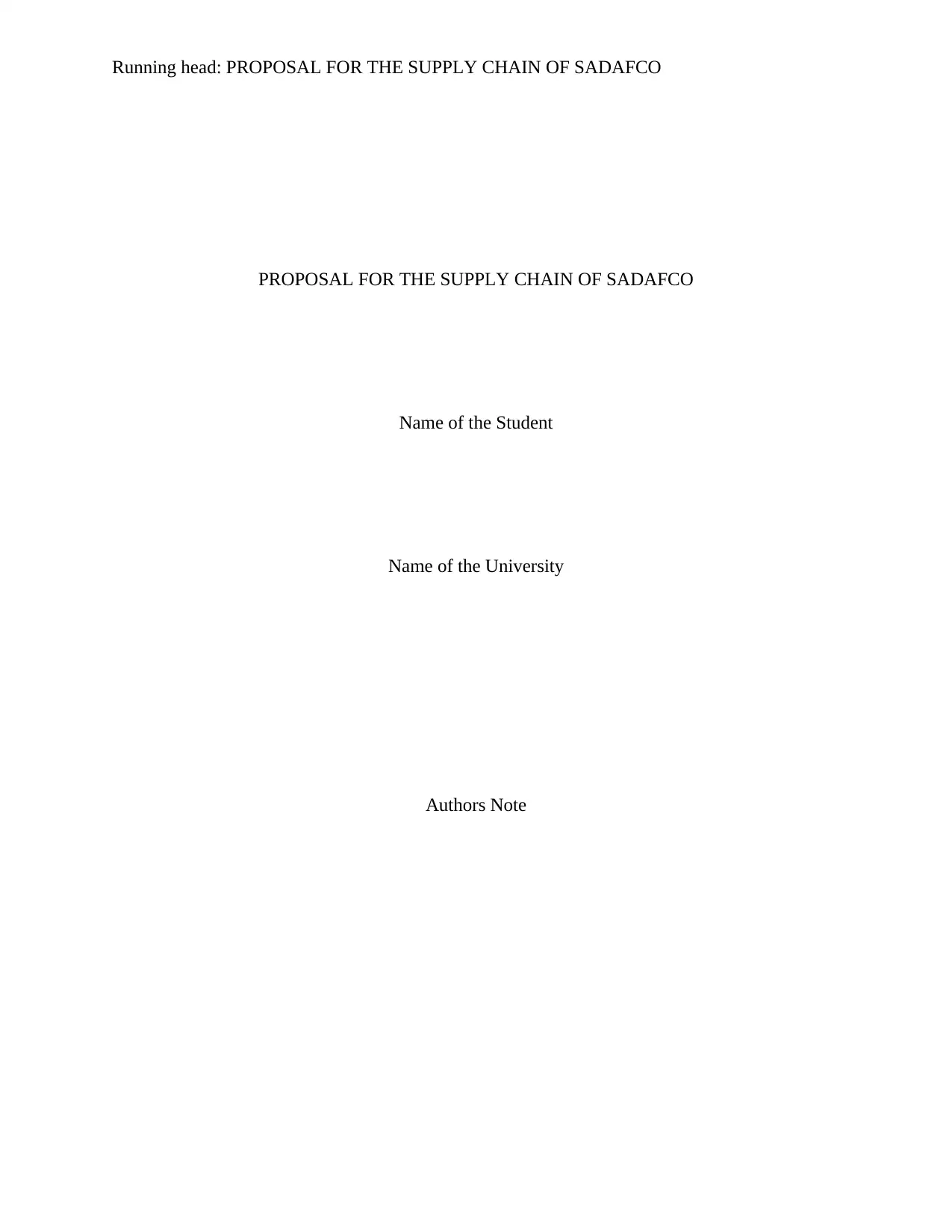
Running head: PROPOSAL FOR THE SUPPLY CHAIN OF SADAFCO
PROPOSAL FOR THE SUPPLY CHAIN OF SADAFCO
Name of the Student
Name of the University
Authors Note
PROPOSAL FOR THE SUPPLY CHAIN OF SADAFCO
Name of the Student
Name of the University
Authors Note
Paraphrase This Document
Need a fresh take? Get an instant paraphrase of this document with our AI Paraphraser
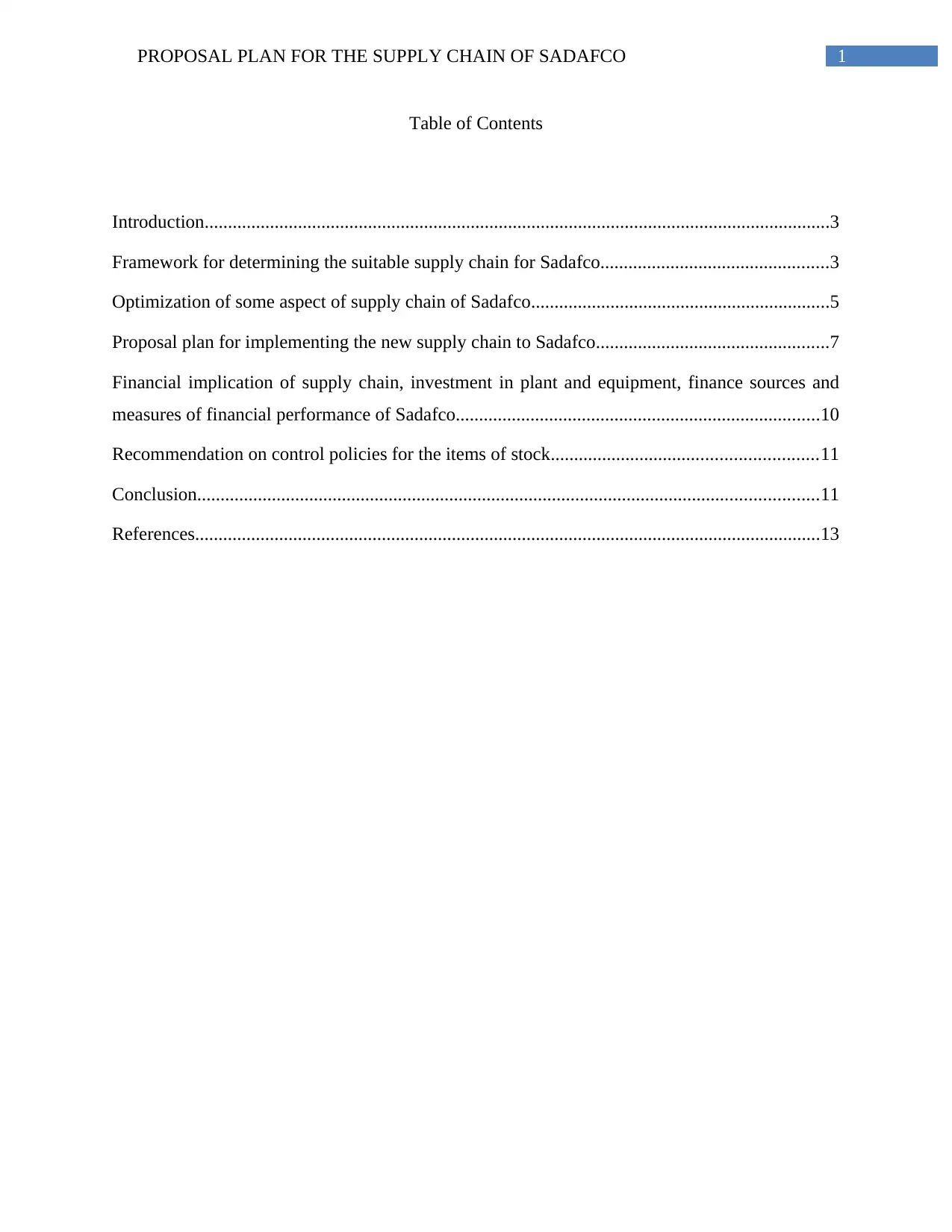
1PROPOSAL PLAN FOR THE SUPPLY CHAIN OF SADAFCO
Table of Contents
Introduction......................................................................................................................................3
Framework for determining the suitable supply chain for Sadafco.................................................3
Optimization of some aspect of supply chain of Sadafco................................................................5
Proposal plan for implementing the new supply chain to Sadafco..................................................7
Financial implication of supply chain, investment in plant and equipment, finance sources and
measures of financial performance of Sadafco..............................................................................10
Recommendation on control policies for the items of stock.........................................................11
Conclusion.....................................................................................................................................11
References......................................................................................................................................13
Table of Contents
Introduction......................................................................................................................................3
Framework for determining the suitable supply chain for Sadafco.................................................3
Optimization of some aspect of supply chain of Sadafco................................................................5
Proposal plan for implementing the new supply chain to Sadafco..................................................7
Financial implication of supply chain, investment in plant and equipment, finance sources and
measures of financial performance of Sadafco..............................................................................10
Recommendation on control policies for the items of stock.........................................................11
Conclusion.....................................................................................................................................11
References......................................................................................................................................13
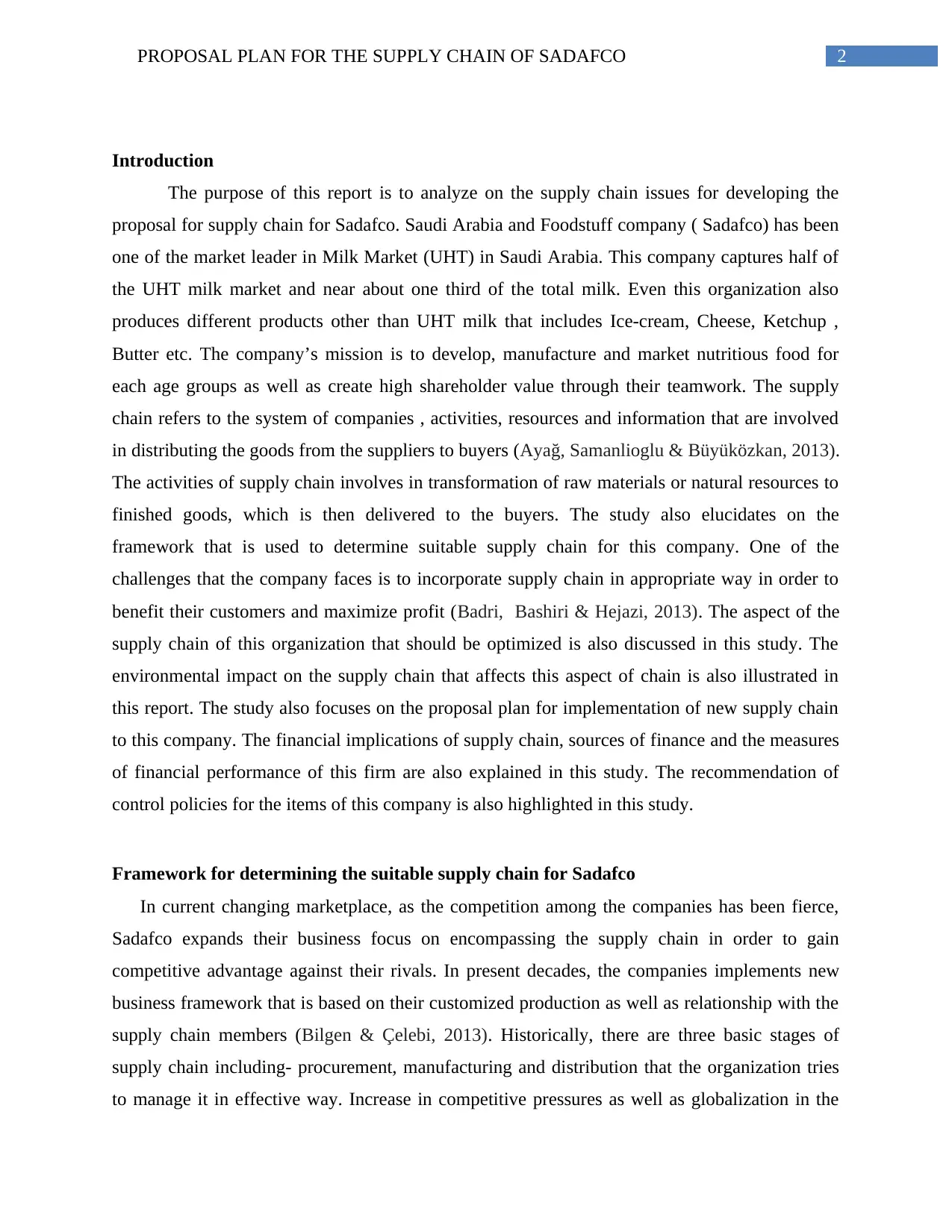
2PROPOSAL PLAN FOR THE SUPPLY CHAIN OF SADAFCO
Introduction
The purpose of this report is to analyze on the supply chain issues for developing the
proposal for supply chain for Sadafco. Saudi Arabia and Foodstuff company ( Sadafco) has been
one of the market leader in Milk Market (UHT) in Saudi Arabia. This company captures half of
the UHT milk market and near about one third of the total milk. Even this organization also
produces different products other than UHT milk that includes Ice-cream, Cheese, Ketchup ,
Butter etc. The company’s mission is to develop, manufacture and market nutritious food for
each age groups as well as create high shareholder value through their teamwork. The supply
chain refers to the system of companies , activities, resources and information that are involved
in distributing the goods from the suppliers to buyers (Ayağ, Samanlioglu & Büyüközkan, 2013).
The activities of supply chain involves in transformation of raw materials or natural resources to
finished goods, which is then delivered to the buyers. The study also elucidates on the
framework that is used to determine suitable supply chain for this company. One of the
challenges that the company faces is to incorporate supply chain in appropriate way in order to
benefit their customers and maximize profit (Badri, Bashiri & Hejazi, 2013). The aspect of the
supply chain of this organization that should be optimized is also discussed in this study. The
environmental impact on the supply chain that affects this aspect of chain is also illustrated in
this report. The study also focuses on the proposal plan for implementation of new supply chain
to this company. The financial implications of supply chain, sources of finance and the measures
of financial performance of this firm are also explained in this study. The recommendation of
control policies for the items of this company is also highlighted in this study.
Framework for determining the suitable supply chain for Sadafco
In current changing marketplace, as the competition among the companies has been fierce,
Sadafco expands their business focus on encompassing the supply chain in order to gain
competitive advantage against their rivals. In present decades, the companies implements new
business framework that is based on their customized production as well as relationship with the
supply chain members (Bilgen & Çelebi, 2013). Historically, there are three basic stages of
supply chain including- procurement, manufacturing and distribution that the organization tries
to manage it in effective way. Increase in competitive pressures as well as globalization in the
Introduction
The purpose of this report is to analyze on the supply chain issues for developing the
proposal for supply chain for Sadafco. Saudi Arabia and Foodstuff company ( Sadafco) has been
one of the market leader in Milk Market (UHT) in Saudi Arabia. This company captures half of
the UHT milk market and near about one third of the total milk. Even this organization also
produces different products other than UHT milk that includes Ice-cream, Cheese, Ketchup ,
Butter etc. The company’s mission is to develop, manufacture and market nutritious food for
each age groups as well as create high shareholder value through their teamwork. The supply
chain refers to the system of companies , activities, resources and information that are involved
in distributing the goods from the suppliers to buyers (Ayağ, Samanlioglu & Büyüközkan, 2013).
The activities of supply chain involves in transformation of raw materials or natural resources to
finished goods, which is then delivered to the buyers. The study also elucidates on the
framework that is used to determine suitable supply chain for this company. One of the
challenges that the company faces is to incorporate supply chain in appropriate way in order to
benefit their customers and maximize profit (Badri, Bashiri & Hejazi, 2013). The aspect of the
supply chain of this organization that should be optimized is also discussed in this study. The
environmental impact on the supply chain that affects this aspect of chain is also illustrated in
this report. The study also focuses on the proposal plan for implementation of new supply chain
to this company. The financial implications of supply chain, sources of finance and the measures
of financial performance of this firm are also explained in this study. The recommendation of
control policies for the items of this company is also highlighted in this study.
Framework for determining the suitable supply chain for Sadafco
In current changing marketplace, as the competition among the companies has been fierce,
Sadafco expands their business focus on encompassing the supply chain in order to gain
competitive advantage against their rivals. In present decades, the companies implements new
business framework that is based on their customized production as well as relationship with the
supply chain members (Bilgen & Çelebi, 2013). Historically, there are three basic stages of
supply chain including- procurement, manufacturing and distribution that the organization tries
to manage it in effective way. Increase in competitive pressures as well as globalization in the
⊘ This is a preview!⊘
Do you want full access?
Subscribe today to unlock all pages.

Trusted by 1+ million students worldwide
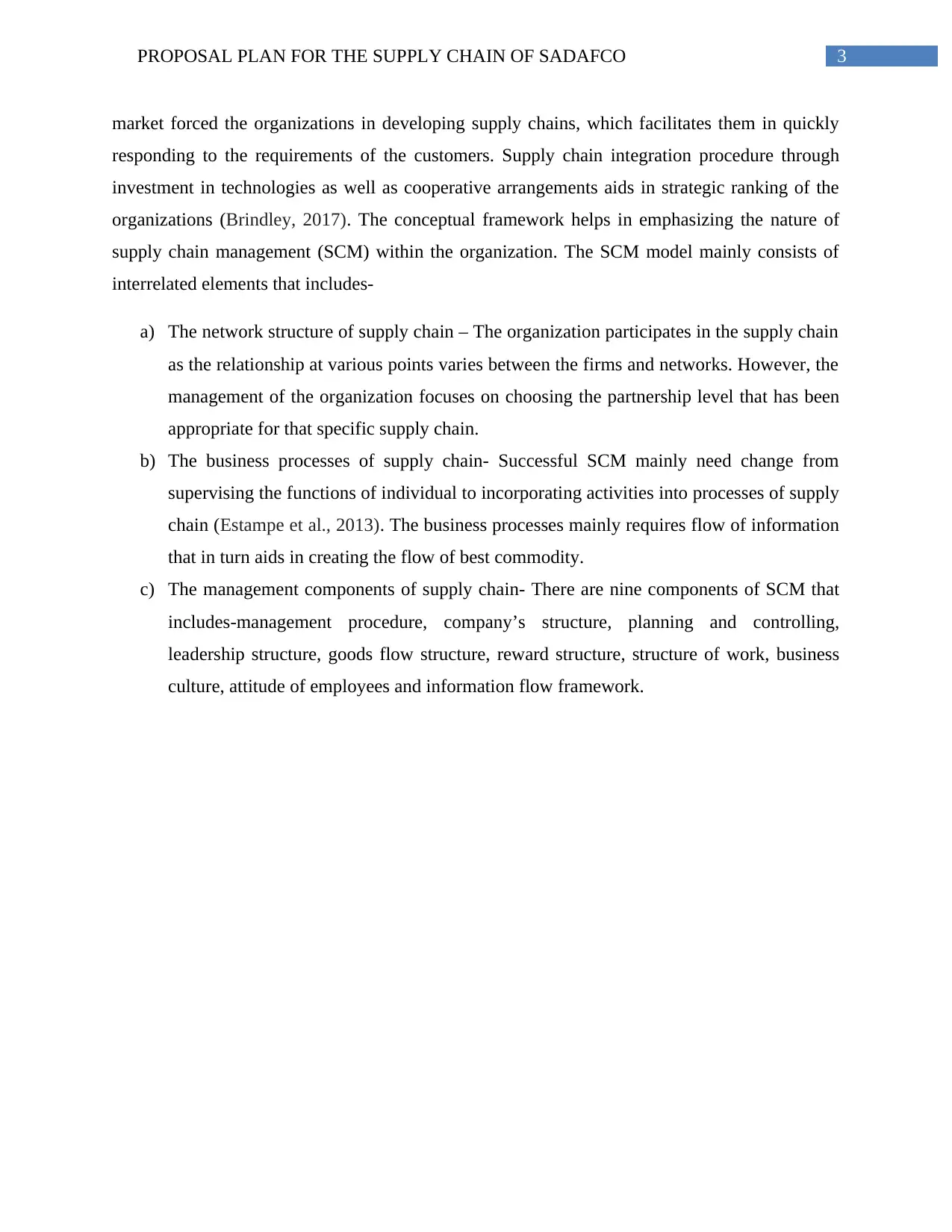
3PROPOSAL PLAN FOR THE SUPPLY CHAIN OF SADAFCO
market forced the organizations in developing supply chains, which facilitates them in quickly
responding to the requirements of the customers. Supply chain integration procedure through
investment in technologies as well as cooperative arrangements aids in strategic ranking of the
organizations (Brindley, 2017). The conceptual framework helps in emphasizing the nature of
supply chain management (SCM) within the organization. The SCM model mainly consists of
interrelated elements that includes-
a) The network structure of supply chain – The organization participates in the supply chain
as the relationship at various points varies between the firms and networks. However, the
management of the organization focuses on choosing the partnership level that has been
appropriate for that specific supply chain.
b) The business processes of supply chain- Successful SCM mainly need change from
supervising the functions of individual to incorporating activities into processes of supply
chain (Estampe et al., 2013). The business processes mainly requires flow of information
that in turn aids in creating the flow of best commodity.
c) The management components of supply chain- There are nine components of SCM that
includes-management procedure, company’s structure, planning and controlling,
leadership structure, goods flow structure, reward structure, structure of work, business
culture, attitude of employees and information flow framework.
market forced the organizations in developing supply chains, which facilitates them in quickly
responding to the requirements of the customers. Supply chain integration procedure through
investment in technologies as well as cooperative arrangements aids in strategic ranking of the
organizations (Brindley, 2017). The conceptual framework helps in emphasizing the nature of
supply chain management (SCM) within the organization. The SCM model mainly consists of
interrelated elements that includes-
a) The network structure of supply chain – The organization participates in the supply chain
as the relationship at various points varies between the firms and networks. However, the
management of the organization focuses on choosing the partnership level that has been
appropriate for that specific supply chain.
b) The business processes of supply chain- Successful SCM mainly need change from
supervising the functions of individual to incorporating activities into processes of supply
chain (Estampe et al., 2013). The business processes mainly requires flow of information
that in turn aids in creating the flow of best commodity.
c) The management components of supply chain- There are nine components of SCM that
includes-management procedure, company’s structure, planning and controlling,
leadership structure, goods flow structure, reward structure, structure of work, business
culture, attitude of employees and information flow framework.
Paraphrase This Document
Need a fresh take? Get an instant paraphrase of this document with our AI Paraphraser
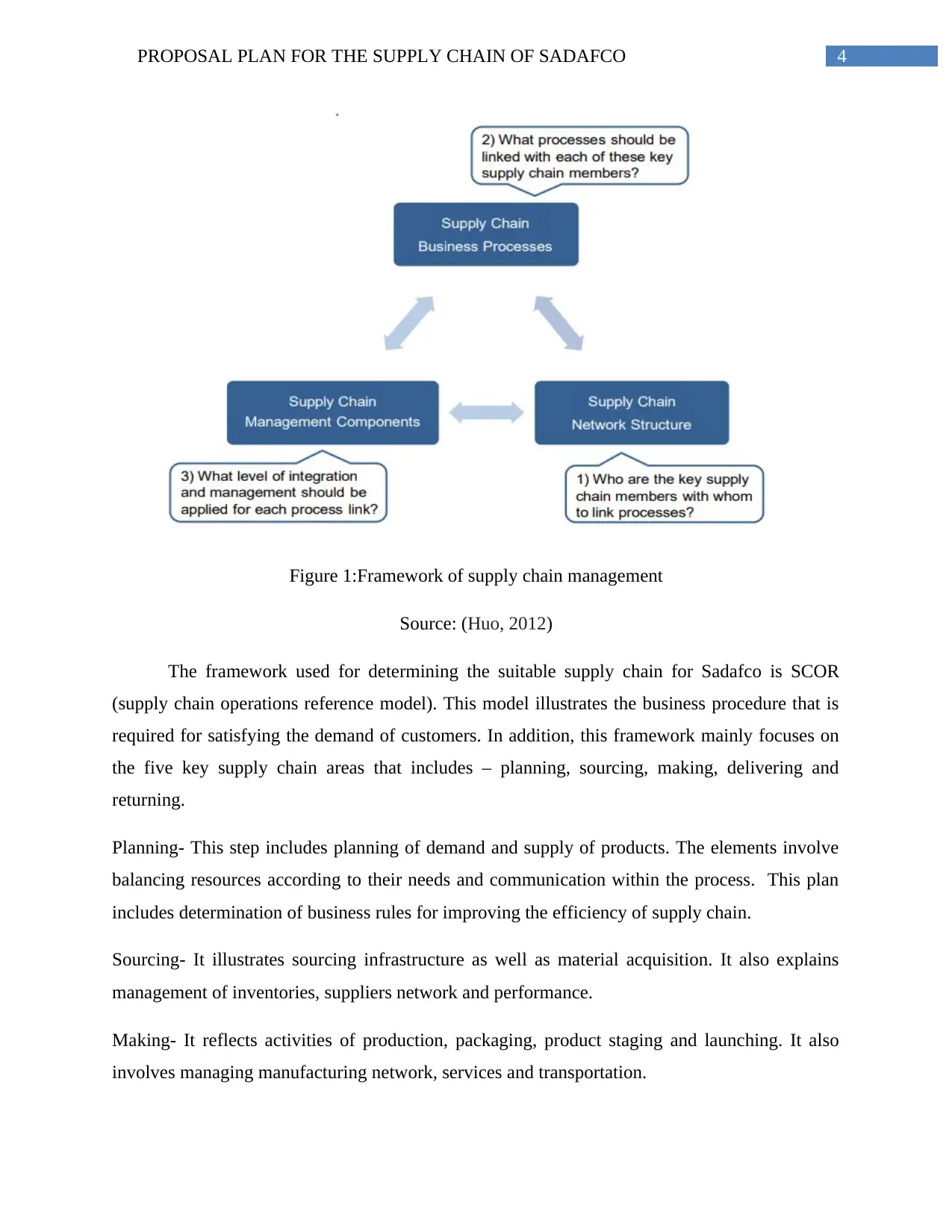
4PROPOSAL PLAN FOR THE SUPPLY CHAIN OF SADAFCO
Figure 1:Framework of supply chain management
Source: (Huo, 2012)
The framework used for determining the suitable supply chain for Sadafco is SCOR
(supply chain operations reference model). This model illustrates the business procedure that is
required for satisfying the demand of customers. In addition, this framework mainly focuses on
the five key supply chain areas that includes – planning, sourcing, making, delivering and
returning.
Planning- This step includes planning of demand and supply of products. The elements involve
balancing resources according to their needs and communication within the process. This plan
includes determination of business rules for improving the efficiency of supply chain.
Sourcing- It illustrates sourcing infrastructure as well as material acquisition. It also explains
management of inventories, suppliers network and performance.
Making- It reflects activities of production, packaging, product staging and launching. It also
involves managing manufacturing network, services and transportation.
Figure 1:Framework of supply chain management
Source: (Huo, 2012)
The framework used for determining the suitable supply chain for Sadafco is SCOR
(supply chain operations reference model). This model illustrates the business procedure that is
required for satisfying the demand of customers. In addition, this framework mainly focuses on
the five key supply chain areas that includes – planning, sourcing, making, delivering and
returning.
Planning- This step includes planning of demand and supply of products. The elements involve
balancing resources according to their needs and communication within the process. This plan
includes determination of business rules for improving the efficiency of supply chain.
Sourcing- It illustrates sourcing infrastructure as well as material acquisition. It also explains
management of inventories, suppliers network and performance.
Making- It reflects activities of production, packaging, product staging and launching. It also
involves managing manufacturing network, services and transportation.
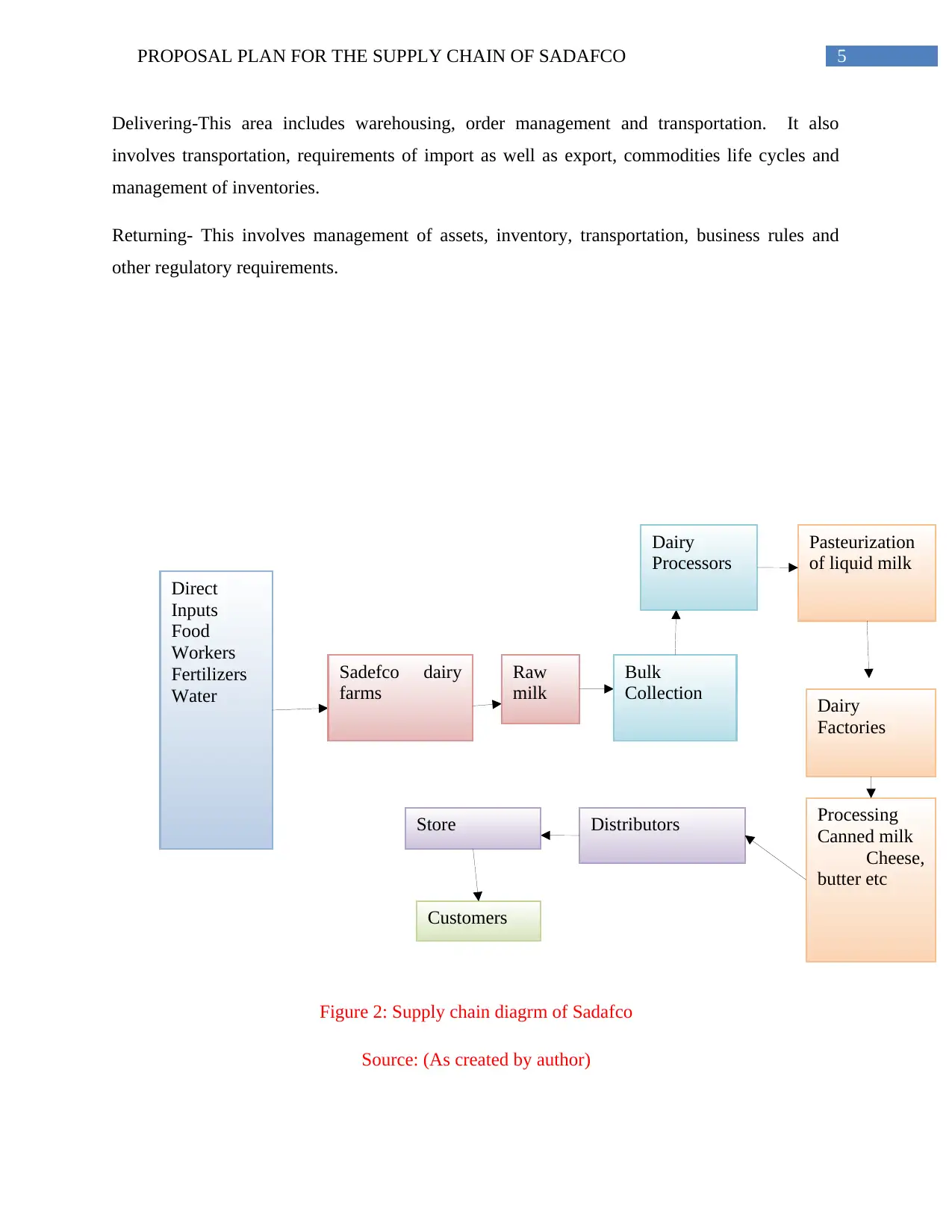
5PROPOSAL PLAN FOR THE SUPPLY CHAIN OF SADAFCO
Direct
Inputs
Food
Workers
Fertilizers
Water
Sadefco dairy
farms
Raw
milk
Bulk
Collection
Dairy
Processors
Pasteurization
of liquid milk
Dairy
Factories
Processing
Canned milk
Cheese,
butter etc
DistributorsStore
Customers
Delivering-This area includes warehousing, order management and transportation. It also
involves transportation, requirements of import as well as export, commodities life cycles and
management of inventories.
Returning- This involves management of assets, inventory, transportation, business rules and
other regulatory requirements.
Figure 2: Supply chain diagrm of Sadafco
Source: (As created by author)
Direct
Inputs
Food
Workers
Fertilizers
Water
Sadefco dairy
farms
Raw
milk
Bulk
Collection
Dairy
Processors
Pasteurization
of liquid milk
Dairy
Factories
Processing
Canned milk
Cheese,
butter etc
DistributorsStore
Customers
Delivering-This area includes warehousing, order management and transportation. It also
involves transportation, requirements of import as well as export, commodities life cycles and
management of inventories.
Returning- This involves management of assets, inventory, transportation, business rules and
other regulatory requirements.
Figure 2: Supply chain diagrm of Sadafco
Source: (As created by author)
⊘ This is a preview!⊘
Do you want full access?
Subscribe today to unlock all pages.

Trusted by 1+ million students worldwide
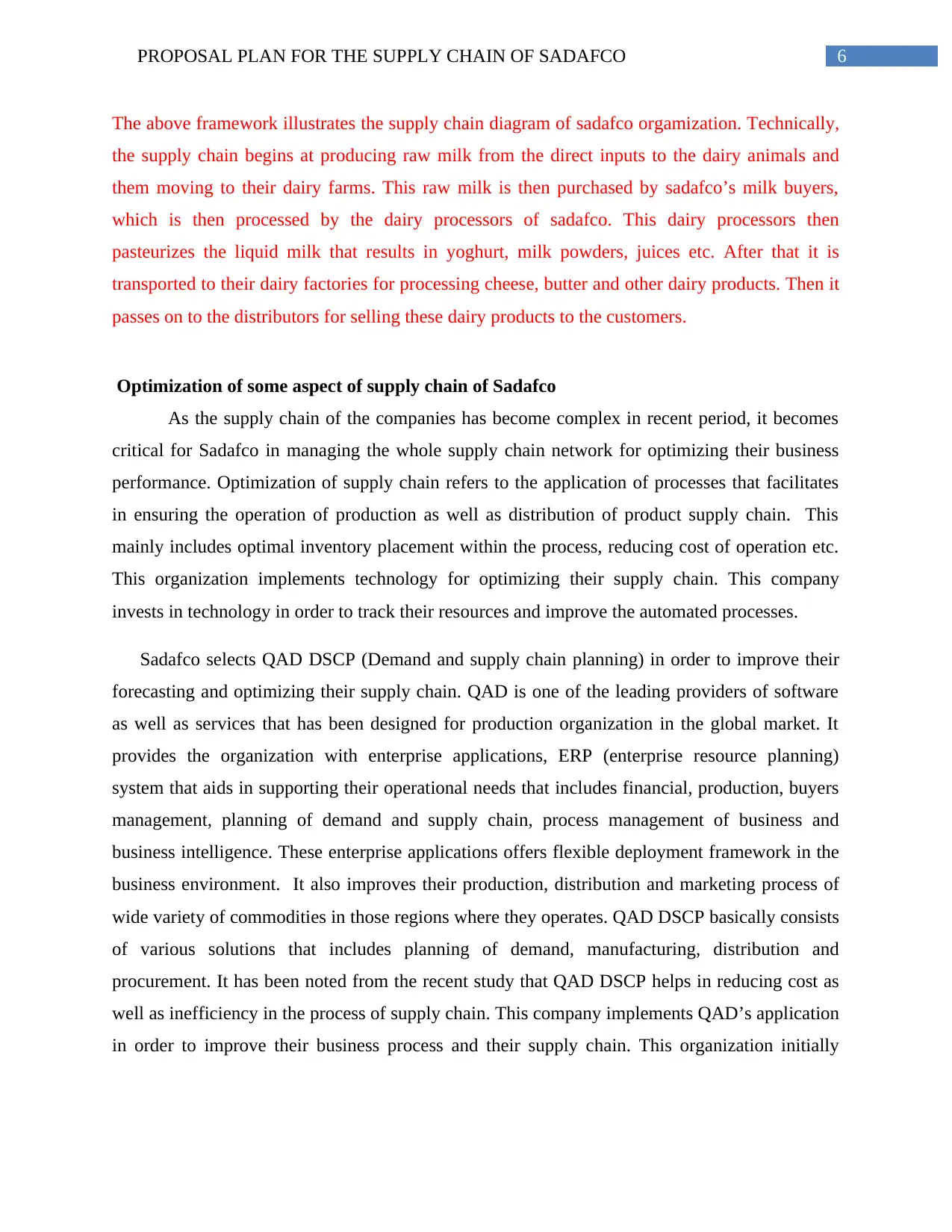
6PROPOSAL PLAN FOR THE SUPPLY CHAIN OF SADAFCO
The above framework illustrates the supply chain diagram of sadafco orgamization. Technically,
the supply chain begins at producing raw milk from the direct inputs to the dairy animals and
them moving to their dairy farms. This raw milk is then purchased by sadafco’s milk buyers,
which is then processed by the dairy processors of sadafco. This dairy processors then
pasteurizes the liquid milk that results in yoghurt, milk powders, juices etc. After that it is
transported to their dairy factories for processing cheese, butter and other dairy products. Then it
passes on to the distributors for selling these dairy products to the customers.
Optimization of some aspect of supply chain of Sadafco
As the supply chain of the companies has become complex in recent period, it becomes
critical for Sadafco in managing the whole supply chain network for optimizing their business
performance. Optimization of supply chain refers to the application of processes that facilitates
in ensuring the operation of production as well as distribution of product supply chain. This
mainly includes optimal inventory placement within the process, reducing cost of operation etc.
This organization implements technology for optimizing their supply chain. This company
invests in technology in order to track their resources and improve the automated processes.
Sadafco selects QAD DSCP (Demand and supply chain planning) in order to improve their
forecasting and optimizing their supply chain. QAD is one of the leading providers of software
as well as services that has been designed for production organization in the global market. It
provides the organization with enterprise applications, ERP (enterprise resource planning)
system that aids in supporting their operational needs that includes financial, production, buyers
management, planning of demand and supply chain, process management of business and
business intelligence. These enterprise applications offers flexible deployment framework in the
business environment. It also improves their production, distribution and marketing process of
wide variety of commodities in those regions where they operates. QAD DSCP basically consists
of various solutions that includes planning of demand, manufacturing, distribution and
procurement. It has been noted from the recent study that QAD DSCP helps in reducing cost as
well as inefficiency in the process of supply chain. This company implements QAD’s application
in order to improve their business process and their supply chain. This organization initially
The above framework illustrates the supply chain diagram of sadafco orgamization. Technically,
the supply chain begins at producing raw milk from the direct inputs to the dairy animals and
them moving to their dairy farms. This raw milk is then purchased by sadafco’s milk buyers,
which is then processed by the dairy processors of sadafco. This dairy processors then
pasteurizes the liquid milk that results in yoghurt, milk powders, juices etc. After that it is
transported to their dairy factories for processing cheese, butter and other dairy products. Then it
passes on to the distributors for selling these dairy products to the customers.
Optimization of some aspect of supply chain of Sadafco
As the supply chain of the companies has become complex in recent period, it becomes
critical for Sadafco in managing the whole supply chain network for optimizing their business
performance. Optimization of supply chain refers to the application of processes that facilitates
in ensuring the operation of production as well as distribution of product supply chain. This
mainly includes optimal inventory placement within the process, reducing cost of operation etc.
This organization implements technology for optimizing their supply chain. This company
invests in technology in order to track their resources and improve the automated processes.
Sadafco selects QAD DSCP (Demand and supply chain planning) in order to improve their
forecasting and optimizing their supply chain. QAD is one of the leading providers of software
as well as services that has been designed for production organization in the global market. It
provides the organization with enterprise applications, ERP (enterprise resource planning)
system that aids in supporting their operational needs that includes financial, production, buyers
management, planning of demand and supply chain, process management of business and
business intelligence. These enterprise applications offers flexible deployment framework in the
business environment. It also improves their production, distribution and marketing process of
wide variety of commodities in those regions where they operates. QAD DSCP basically consists
of various solutions that includes planning of demand, manufacturing, distribution and
procurement. It has been noted from the recent study that QAD DSCP helps in reducing cost as
well as inefficiency in the process of supply chain. This company implements QAD’s application
in order to improve their business process and their supply chain. This organization initially
Paraphrase This Document
Need a fresh take? Get an instant paraphrase of this document with our AI Paraphraser
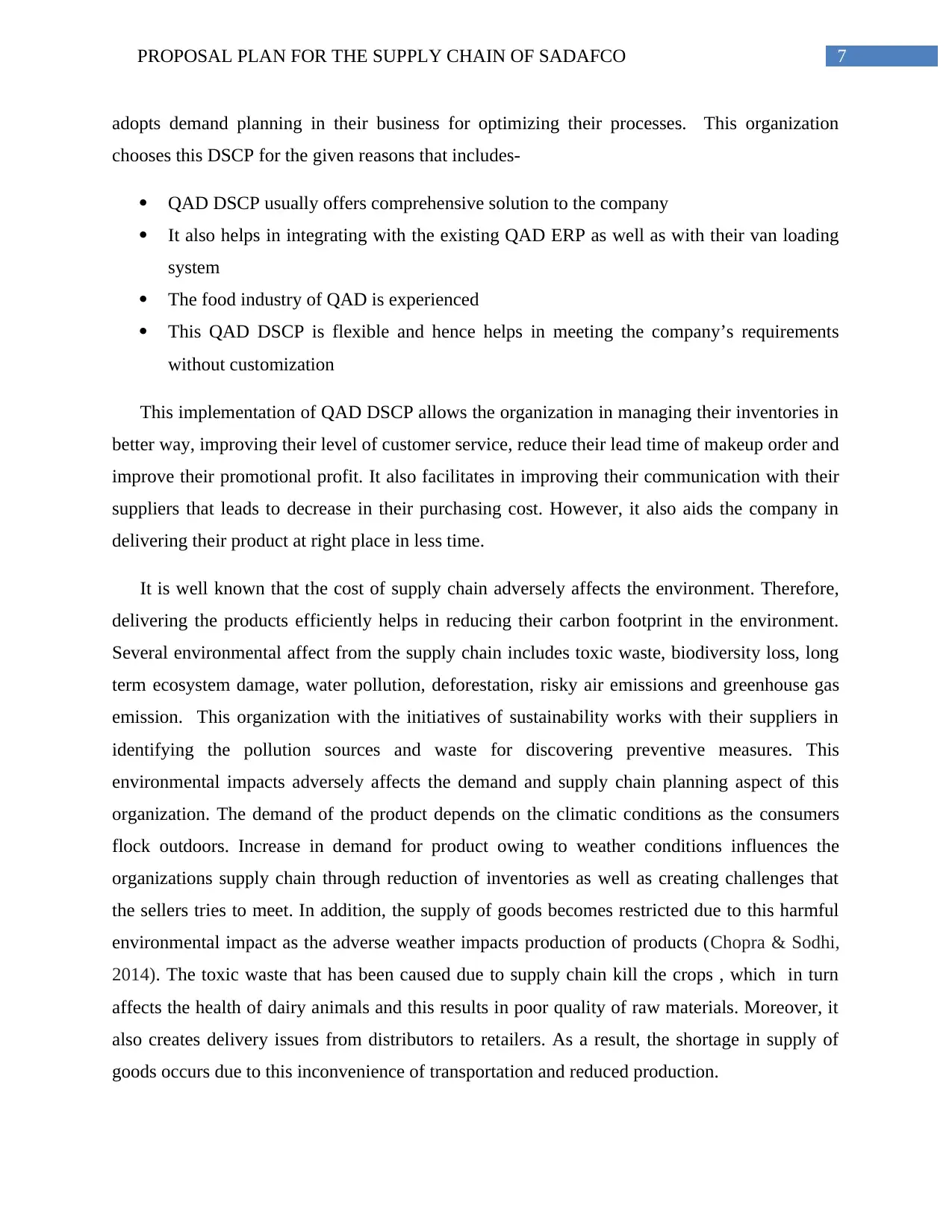
7PROPOSAL PLAN FOR THE SUPPLY CHAIN OF SADAFCO
adopts demand planning in their business for optimizing their processes. This organization
chooses this DSCP for the given reasons that includes-
QAD DSCP usually offers comprehensive solution to the company
It also helps in integrating with the existing QAD ERP as well as with their van loading
system
The food industry of QAD is experienced
This QAD DSCP is flexible and hence helps in meeting the company’s requirements
without customization
This implementation of QAD DSCP allows the organization in managing their inventories in
better way, improving their level of customer service, reduce their lead time of makeup order and
improve their promotional profit. It also facilitates in improving their communication with their
suppliers that leads to decrease in their purchasing cost. However, it also aids the company in
delivering their product at right place in less time.
It is well known that the cost of supply chain adversely affects the environment. Therefore,
delivering the products efficiently helps in reducing their carbon footprint in the environment.
Several environmental affect from the supply chain includes toxic waste, biodiversity loss, long
term ecosystem damage, water pollution, deforestation, risky air emissions and greenhouse gas
emission. This organization with the initiatives of sustainability works with their suppliers in
identifying the pollution sources and waste for discovering preventive measures. This
environmental impacts adversely affects the demand and supply chain planning aspect of this
organization. The demand of the product depends on the climatic conditions as the consumers
flock outdoors. Increase in demand for product owing to weather conditions influences the
organizations supply chain through reduction of inventories as well as creating challenges that
the sellers tries to meet. In addition, the supply of goods becomes restricted due to this harmful
environmental impact as the adverse weather impacts production of products (Chopra & Sodhi,
2014). The toxic waste that has been caused due to supply chain kill the crops , which in turn
affects the health of dairy animals and this results in poor quality of raw materials. Moreover, it
also creates delivery issues from distributors to retailers. As a result, the shortage in supply of
goods occurs due to this inconvenience of transportation and reduced production.
adopts demand planning in their business for optimizing their processes. This organization
chooses this DSCP for the given reasons that includes-
QAD DSCP usually offers comprehensive solution to the company
It also helps in integrating with the existing QAD ERP as well as with their van loading
system
The food industry of QAD is experienced
This QAD DSCP is flexible and hence helps in meeting the company’s requirements
without customization
This implementation of QAD DSCP allows the organization in managing their inventories in
better way, improving their level of customer service, reduce their lead time of makeup order and
improve their promotional profit. It also facilitates in improving their communication with their
suppliers that leads to decrease in their purchasing cost. However, it also aids the company in
delivering their product at right place in less time.
It is well known that the cost of supply chain adversely affects the environment. Therefore,
delivering the products efficiently helps in reducing their carbon footprint in the environment.
Several environmental affect from the supply chain includes toxic waste, biodiversity loss, long
term ecosystem damage, water pollution, deforestation, risky air emissions and greenhouse gas
emission. This organization with the initiatives of sustainability works with their suppliers in
identifying the pollution sources and waste for discovering preventive measures. This
environmental impacts adversely affects the demand and supply chain planning aspect of this
organization. The demand of the product depends on the climatic conditions as the consumers
flock outdoors. Increase in demand for product owing to weather conditions influences the
organizations supply chain through reduction of inventories as well as creating challenges that
the sellers tries to meet. In addition, the supply of goods becomes restricted due to this harmful
environmental impact as the adverse weather impacts production of products (Chopra & Sodhi,
2014). The toxic waste that has been caused due to supply chain kill the crops , which in turn
affects the health of dairy animals and this results in poor quality of raw materials. Moreover, it
also creates delivery issues from distributors to retailers. As a result, the shortage in supply of
goods occurs due to this inconvenience of transportation and reduced production.

8PROPOSAL PLAN FOR THE SUPPLY CHAIN OF SADAFCO
Proposal plan for implementing the new supply chain to Sadafco
This organization is mainly based on IDI (Interfirm demand integration) process. IDI
process refers to the systematic coordination of functions that is consumer focused and tactics
used in the process of supply chain. It main purpose is to improve the financial performance of
each organization and whole of its supply chain. (Rushton, Croucher & Baker, 2012) This
procedure mainly consists of three activities that are being coordinated between the trading
partners that includes demand management, demand planning and collaborative forecasting.
Each of this helps in improving the performance of supply chain.
Demand management- These activities are applied for creating demand in order to optimize
product supply. This might include various forms namely- exclusive goods, packaging as well as
bundling options. Brand promotions etc,
Demand planning- it refers to the coordination of dependent flow through organization in supply
chain. Therefore, dependent demand refers to the demand for materials that has been taken from
customer demand for any particular commodities.
Collaborative planning- it refers to the exchange of information among the trading partners for
developing single shared demand projection.
The implementation of this process revealed the direct relationship between incorporation of
activities in business and enhancing performance of supply chain.
Proposal plan for implementing the new supply chain to Sadafco
This organization is mainly based on IDI (Interfirm demand integration) process. IDI
process refers to the systematic coordination of functions that is consumer focused and tactics
used in the process of supply chain. It main purpose is to improve the financial performance of
each organization and whole of its supply chain. (Rushton, Croucher & Baker, 2012) This
procedure mainly consists of three activities that are being coordinated between the trading
partners that includes demand management, demand planning and collaborative forecasting.
Each of this helps in improving the performance of supply chain.
Demand management- These activities are applied for creating demand in order to optimize
product supply. This might include various forms namely- exclusive goods, packaging as well as
bundling options. Brand promotions etc,
Demand planning- it refers to the coordination of dependent flow through organization in supply
chain. Therefore, dependent demand refers to the demand for materials that has been taken from
customer demand for any particular commodities.
Collaborative planning- it refers to the exchange of information among the trading partners for
developing single shared demand projection.
The implementation of this process revealed the direct relationship between incorporation of
activities in business and enhancing performance of supply chain.
⊘ This is a preview!⊘
Do you want full access?
Subscribe today to unlock all pages.

Trusted by 1+ million students worldwide
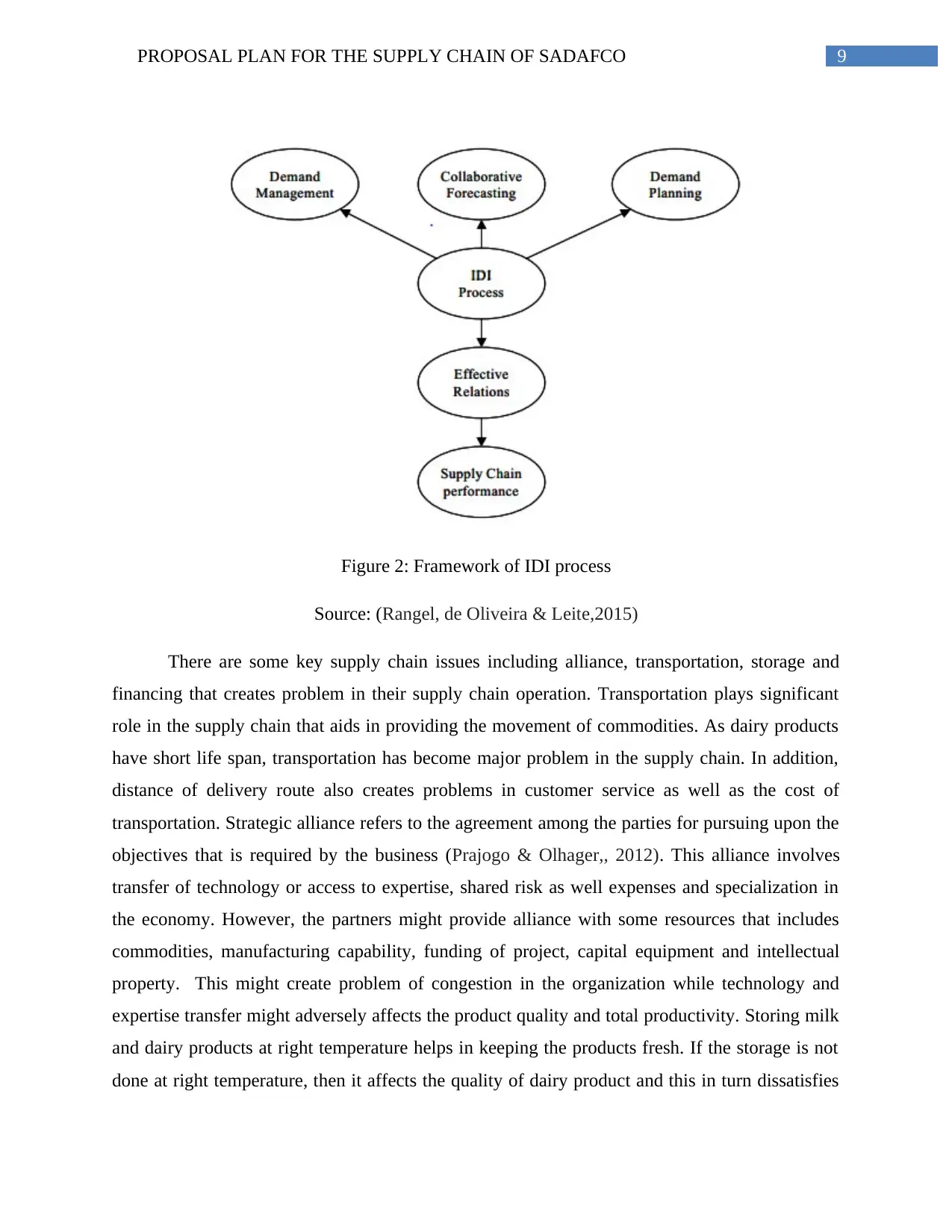
9PROPOSAL PLAN FOR THE SUPPLY CHAIN OF SADAFCO
Figure 2: Framework of IDI process
Source: (Rangel, de Oliveira & Leite,2015)
There are some key supply chain issues including alliance, transportation, storage and
financing that creates problem in their supply chain operation. Transportation plays significant
role in the supply chain that aids in providing the movement of commodities. As dairy products
have short life span, transportation has become major problem in the supply chain. In addition,
distance of delivery route also creates problems in customer service as well as the cost of
transportation. Strategic alliance refers to the agreement among the parties for pursuing upon the
objectives that is required by the business (Prajogo & Olhager,, 2012). This alliance involves
transfer of technology or access to expertise, shared risk as well expenses and specialization in
the economy. However, the partners might provide alliance with some resources that includes
commodities, manufacturing capability, funding of project, capital equipment and intellectual
property. This might create problem of congestion in the organization while technology and
expertise transfer might adversely affects the product quality and total productivity. Storing milk
and dairy products at right temperature helps in keeping the products fresh. If the storage is not
done at right temperature, then it affects the quality of dairy product and this in turn dissatisfies
Figure 2: Framework of IDI process
Source: (Rangel, de Oliveira & Leite,2015)
There are some key supply chain issues including alliance, transportation, storage and
financing that creates problem in their supply chain operation. Transportation plays significant
role in the supply chain that aids in providing the movement of commodities. As dairy products
have short life span, transportation has become major problem in the supply chain. In addition,
distance of delivery route also creates problems in customer service as well as the cost of
transportation. Strategic alliance refers to the agreement among the parties for pursuing upon the
objectives that is required by the business (Prajogo & Olhager,, 2012). This alliance involves
transfer of technology or access to expertise, shared risk as well expenses and specialization in
the economy. However, the partners might provide alliance with some resources that includes
commodities, manufacturing capability, funding of project, capital equipment and intellectual
property. This might create problem of congestion in the organization while technology and
expertise transfer might adversely affects the product quality and total productivity. Storing milk
and dairy products at right temperature helps in keeping the products fresh. If the storage is not
done at right temperature, then it affects the quality of dairy product and this in turn dissatisfies
Paraphrase This Document
Need a fresh take? Get an instant paraphrase of this document with our AI Paraphraser
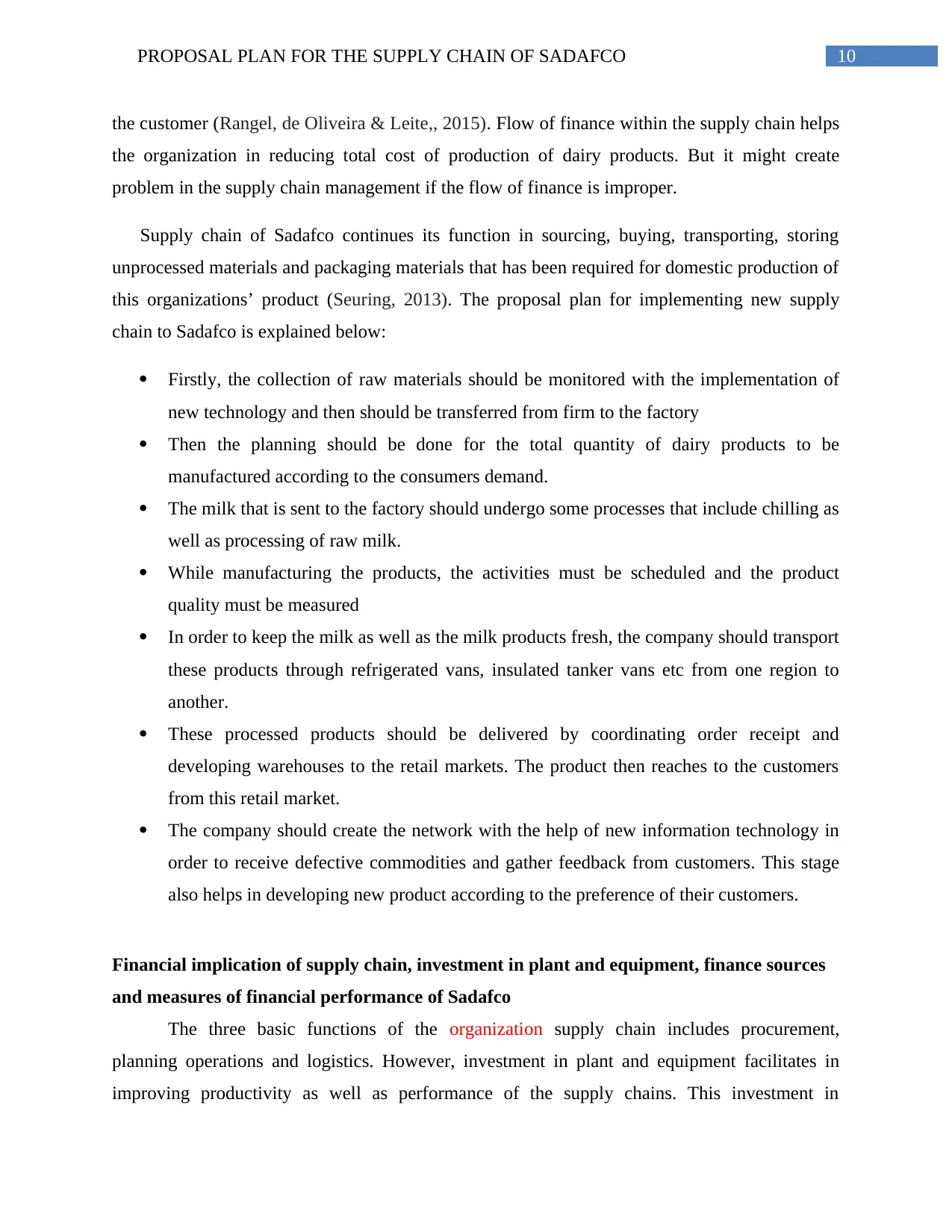
10PROPOSAL PLAN FOR THE SUPPLY CHAIN OF SADAFCO
the customer (Rangel, de Oliveira & Leite,, 2015). Flow of finance within the supply chain helps
the organization in reducing total cost of production of dairy products. But it might create
problem in the supply chain management if the flow of finance is improper.
Supply chain of Sadafco continues its function in sourcing, buying, transporting, storing
unprocessed materials and packaging materials that has been required for domestic production of
this organizations’ product (Seuring, 2013). The proposal plan for implementing new supply
chain to Sadafco is explained below:
Firstly, the collection of raw materials should be monitored with the implementation of
new technology and then should be transferred from firm to the factory
Then the planning should be done for the total quantity of dairy products to be
manufactured according to the consumers demand.
The milk that is sent to the factory should undergo some processes that include chilling as
well as processing of raw milk.
While manufacturing the products, the activities must be scheduled and the product
quality must be measured
In order to keep the milk as well as the milk products fresh, the company should transport
these products through refrigerated vans, insulated tanker vans etc from one region to
another.
These processed products should be delivered by coordinating order receipt and
developing warehouses to the retail markets. The product then reaches to the customers
from this retail market.
The company should create the network with the help of new information technology in
order to receive defective commodities and gather feedback from customers. This stage
also helps in developing new product according to the preference of their customers.
Financial implication of supply chain, investment in plant and equipment, finance sources
and measures of financial performance of Sadafco
The three basic functions of the organization supply chain includes procurement,
planning operations and logistics. However, investment in plant and equipment facilitates in
improving productivity as well as performance of the supply chains. This investment in
the customer (Rangel, de Oliveira & Leite,, 2015). Flow of finance within the supply chain helps
the organization in reducing total cost of production of dairy products. But it might create
problem in the supply chain management if the flow of finance is improper.
Supply chain of Sadafco continues its function in sourcing, buying, transporting, storing
unprocessed materials and packaging materials that has been required for domestic production of
this organizations’ product (Seuring, 2013). The proposal plan for implementing new supply
chain to Sadafco is explained below:
Firstly, the collection of raw materials should be monitored with the implementation of
new technology and then should be transferred from firm to the factory
Then the planning should be done for the total quantity of dairy products to be
manufactured according to the consumers demand.
The milk that is sent to the factory should undergo some processes that include chilling as
well as processing of raw milk.
While manufacturing the products, the activities must be scheduled and the product
quality must be measured
In order to keep the milk as well as the milk products fresh, the company should transport
these products through refrigerated vans, insulated tanker vans etc from one region to
another.
These processed products should be delivered by coordinating order receipt and
developing warehouses to the retail markets. The product then reaches to the customers
from this retail market.
The company should create the network with the help of new information technology in
order to receive defective commodities and gather feedback from customers. This stage
also helps in developing new product according to the preference of their customers.
Financial implication of supply chain, investment in plant and equipment, finance sources
and measures of financial performance of Sadafco
The three basic functions of the organization supply chain includes procurement,
planning operations and logistics. However, investment in plant and equipment facilitates in
improving productivity as well as performance of the supply chains. This investment in
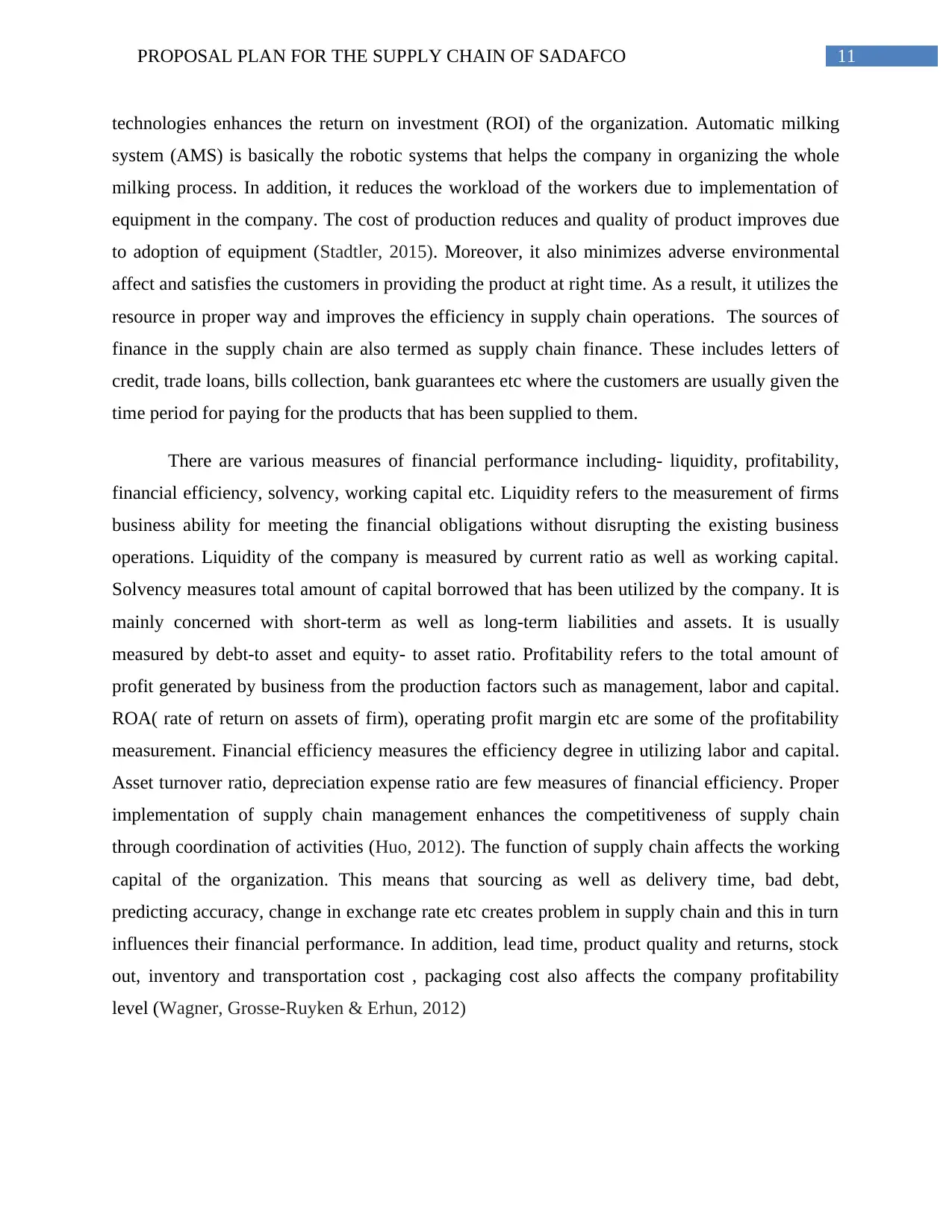
11PROPOSAL PLAN FOR THE SUPPLY CHAIN OF SADAFCO
technologies enhances the return on investment (ROI) of the organization. Automatic milking
system (AMS) is basically the robotic systems that helps the company in organizing the whole
milking process. In addition, it reduces the workload of the workers due to implementation of
equipment in the company. The cost of production reduces and quality of product improves due
to adoption of equipment (Stadtler, 2015). Moreover, it also minimizes adverse environmental
affect and satisfies the customers in providing the product at right time. As a result, it utilizes the
resource in proper way and improves the efficiency in supply chain operations. The sources of
finance in the supply chain are also termed as supply chain finance. These includes letters of
credit, trade loans, bills collection, bank guarantees etc where the customers are usually given the
time period for paying for the products that has been supplied to them.
There are various measures of financial performance including- liquidity, profitability,
financial efficiency, solvency, working capital etc. Liquidity refers to the measurement of firms
business ability for meeting the financial obligations without disrupting the existing business
operations. Liquidity of the company is measured by current ratio as well as working capital.
Solvency measures total amount of capital borrowed that has been utilized by the company. It is
mainly concerned with short-term as well as long-term liabilities and assets. It is usually
measured by debt-to asset and equity- to asset ratio. Profitability refers to the total amount of
profit generated by business from the production factors such as management, labor and capital.
ROA( rate of return on assets of firm), operating profit margin etc are some of the profitability
measurement. Financial efficiency measures the efficiency degree in utilizing labor and capital.
Asset turnover ratio, depreciation expense ratio are few measures of financial efficiency. Proper
implementation of supply chain management enhances the competitiveness of supply chain
through coordination of activities (Huo, 2012). The function of supply chain affects the working
capital of the organization. This means that sourcing as well as delivery time, bad debt,
predicting accuracy, change in exchange rate etc creates problem in supply chain and this in turn
influences their financial performance. In addition, lead time, product quality and returns, stock
out, inventory and transportation cost , packaging cost also affects the company profitability
level (Wagner, Grosse-Ruyken & Erhun, 2012)
technologies enhances the return on investment (ROI) of the organization. Automatic milking
system (AMS) is basically the robotic systems that helps the company in organizing the whole
milking process. In addition, it reduces the workload of the workers due to implementation of
equipment in the company. The cost of production reduces and quality of product improves due
to adoption of equipment (Stadtler, 2015). Moreover, it also minimizes adverse environmental
affect and satisfies the customers in providing the product at right time. As a result, it utilizes the
resource in proper way and improves the efficiency in supply chain operations. The sources of
finance in the supply chain are also termed as supply chain finance. These includes letters of
credit, trade loans, bills collection, bank guarantees etc where the customers are usually given the
time period for paying for the products that has been supplied to them.
There are various measures of financial performance including- liquidity, profitability,
financial efficiency, solvency, working capital etc. Liquidity refers to the measurement of firms
business ability for meeting the financial obligations without disrupting the existing business
operations. Liquidity of the company is measured by current ratio as well as working capital.
Solvency measures total amount of capital borrowed that has been utilized by the company. It is
mainly concerned with short-term as well as long-term liabilities and assets. It is usually
measured by debt-to asset and equity- to asset ratio. Profitability refers to the total amount of
profit generated by business from the production factors such as management, labor and capital.
ROA( rate of return on assets of firm), operating profit margin etc are some of the profitability
measurement. Financial efficiency measures the efficiency degree in utilizing labor and capital.
Asset turnover ratio, depreciation expense ratio are few measures of financial efficiency. Proper
implementation of supply chain management enhances the competitiveness of supply chain
through coordination of activities (Huo, 2012). The function of supply chain affects the working
capital of the organization. This means that sourcing as well as delivery time, bad debt,
predicting accuracy, change in exchange rate etc creates problem in supply chain and this in turn
influences their financial performance. In addition, lead time, product quality and returns, stock
out, inventory and transportation cost , packaging cost also affects the company profitability
level (Wagner, Grosse-Ruyken & Erhun, 2012)
⊘ This is a preview!⊘
Do you want full access?
Subscribe today to unlock all pages.

Trusted by 1+ million students worldwide
1 out of 17
Related Documents
Your All-in-One AI-Powered Toolkit for Academic Success.
+13062052269
info@desklib.com
Available 24*7 on WhatsApp / Email
![[object Object]](/_next/static/media/star-bottom.7253800d.svg)
Unlock your academic potential
Copyright © 2020–2025 A2Z Services. All Rights Reserved. Developed and managed by ZUCOL.





